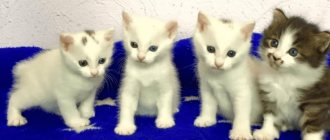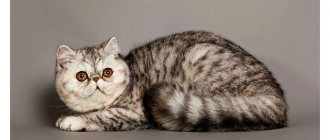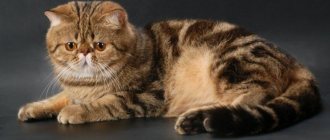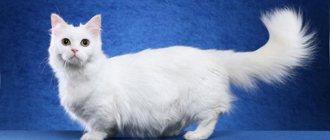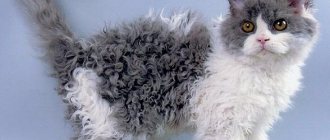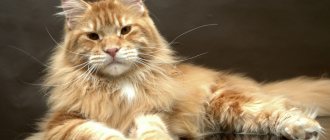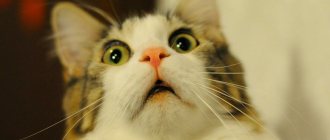Exotic cat breed
The most famous representative of the breed is the big-eyed cat Snoopy. She truly became the idol of millions after the owner posted touching photos of her pet online. This cat has unusually expressive eyes, which also have an unusual cutout that gives Snoopy a slightly sad look.
The exotic breed first appeared in America after crossing local short-haired animals with Persians. Today, in many ways, the breed standards coincide with the requirements for the Persian breed. An exotic shorthair cat is not a cheap purchase. A kitten with big eyes of a similar breed will cost the owner 20-40 thousand rubles.
No. 8. Abyssinian cat
Wild African cats, the ancestors of modern Abyssinians, endowed the animal with grace and sandy color. During selection, the color scheme varied with such shades as lilac, chocolate, silver and blue.
The transparency of the green eyes is full of charm, and the movements of the slender body are aristocratic. The Abyssinian cat needs vaccinations. The fragile health of the delicate animal often falls victim to leukemia.
British Shorthair Chinchilla
A rather rare species of cat for our latitudes. Internet users will be able to remember the white cat with the big eyes of the Kobi - a representative of this particular breed. Kobe became famous for her unusually large, blue eyes with black stripes around the edges. Short-haired chinchillas are rare, so breeders can demand a fairly large sum for a kitten - from 30 thousand rubles.
Body structure
- Head: round skull, rounded forehead, full, well-defined cheeks. The chin is of strong construction with a wide jaw, a short, flattened nose.
- The ears are low set, compact, rounded, with tufts of long hair at the ends.
- The eyes are large, round, widely spaced, the color and intensity of the color depends on the type of breed.
- The neck is short and strong.
- The body is muscular with a wide chest. The neck and back are massive.
- The limbs are short, massive, thick bones. The feet are large and round with tufts of long hair between the toes.
- The tail is short, very fluffy, curved at the end, proportional to the rest of the body.
- The fur is long, fluffy, soft and silky, around the neck there is a pronounced collar with not very long hair sticking out like a hedgehog.
Devon Rex cat
Another breed of cute cats with big eyes is the Devon Rex. This variety is distinguished not only by its large facial features, but also by its unusual wavy coat. The short muzzle makes the huge eyes even more expressive, and the overall grace of the physique amazes even cat connoisseurs. The Devon Rex first appeared in England at the beginning of the 20th century, but has already managed to win the love and recognition of breeders from all over the world.
No. 1. These funny Persian cats
The Persian cat is one of the most popular and widespread big-eyed breeds. Over many decades, their appearance has undergone significant selective changes, but one thing has remained unchanged - long, thick, very soft and pleasant to the touch wool. Today it is a well-proportioned animal with a flexible tail and a flattened muzzle with a snub nose button. The cat's eyes are large, round in shape, with an unblinking, attentive gaze. Small ears and an upturned nose make the Persian's face funny, childishly cute and spontaneous.
Persian cats are quite calm, even phlegmatic. This trait makes life very easy for their owner. Caring for a luxurious fur coat requires a lot of time and effort. It would be very difficult to wash and scratch a restless cat. And this is simply necessary. To keep the coat healthy, it requires daily brushing. And also special shampoos to maintain hair, vitamin supplements and lots and lots of love. There is nothing to compare with the aesthetic pleasure when you look into two bottomless pupils looking out from a fluffy woolen cloud.
Ukrainian lefty cat
A relatively new breed of cats with big eyes, which, as the name suggests, was bred in Ukraine. Levkoys are very similar to sphinxes, with one difference - “dangling” ears, like the British. The unusual appearance of cats did not scare off fans, and Levkoys quickly became popular both in Ukraine and Russia. The Don Sphynx and the best representatives of the Scottish Fold were used for breeding. The first nursery was created only in 2007.
No. 5. Unique Ragdoll
A breed of American origin with a large body and an imposing disposition. Short-haired animals can have different eye colors on a large head: amber, blue, green. Soft and thick wool also varies in shades.
What makes the ragdoll unique is its ability to completely relax in the hands of a person. Translated, the name of the breed sounds like “rag doll.” The animal loves to play with children, and in general is very attached to humans.
How to care for a cat with big eyes
Cat breeds with huge eyes are often predisposed to vision-related diseases. Therefore, it is necessary to carefully care for your pet and consult a veterinarian in time in case of any ailment.
To protect the eyeball from damage, the body constantly produces tear fluid. In breeds of cats and cats with huge eyes, excess fluid synthesis occurs, as a result of which dried tracks and crusts from tears form on the fur and around the organs of vision. They need to be cleaned regularly with a special liquid or lotion, because... Such crusts are a favorable place for the proliferation of microorganisms.
Most cats with big eyes are purebred animals with special needs. They cannot be fed economy food. It is best to buy food that takes into account the specific needs of this particular breed.
Breeds not included in the top ten most famous
Some of the cutest cats with big eyes come from random mutations and selection. An expressive look can be found in many representatives of the cat breed, but few have truly huge eyes.
Cats with different eyes - examples of what breeds are called
One of the most popular cats, not included in the top ten famous ones, is Cobby the British shorthaired chinchilla. All representatives of this variety have a bluish-gray coat color, and Cobby has a snow-white coat, perfectly combined with huge sky-blue eyes. They are incredibly expressive thanks to the black edging.
The next representative, often compared to the Cheshire cat, is Gimo. This is a cute cat with huge golden eyes.
Snoopy the cat is a short-haired exotic cat with huge eyes. He has an innocent, wise look, which contains natural charm.
Note! Due to the huge visual organ, these animals have a visual angle of 170-185 degrees. For representatives of the cat breed with normal eyes, this angle is 160-169 degrees.
Snoopy the Cat
Education and training
High intelligence allows you to teach cats several tricks, but at this moment they must be in a good mood. The main thing is to captivate the fluffy beauty, and then there will be no difficulties with training.
If desired, cats can be trained:
- stand on your hind legs;
- bring toys;
- jump over a barrier or hoop.
Important! Walks with your pet take place on a harness - he must be familiar with it in advance. If the “decoration” is refused, the animal is cajoled, a leash is put on for several minutes, gradually increasing the time.
Bobtail kitten is cheerful and active
Persians: a look from time immemorial
Big-eyed and fluffy Persian cats are a gift from the East: they came to Europe from Persia (present-day Iran) about 400 years ago.
Large and round, like saucers, widely spaced bright eyes are one of the signs of the Persian breed. Depending on the color of the animal, they can be orange, copper, bright green or blue. Breeders all over the world strive to ensure that the eyes of a purebred Persian are large, round, expressive and shine like stars. And honestly, their efforts were crowned with success, you can see this for yourself - we have collected for you a selection of photographs of the most titled Persian cats. Admire their luxurious coat and incredibly beautiful eyes.
Reproduction and lifespan
Representatives of both sexes can breed starting from 10-12 months, but breeders recommend the first introduction no earlier than one and a half years. The female brings from 2 to 7 kittens; large offspring require help from the owner with supplementary feeding and complementary feeding of the babies.
Japanese furry beauties, despite their constantly active life, can delight their owners for 15-18 years. The duration is influenced by the conditions created and the frequency of colds.
How to choose?
First of all, you need to check the documents, and you should also pay attention to how the kitten behaves. He must be active and not show fear or aggression. It is also worth observing the behavior of the kitten’s parents. Eyes and ears must be clean. Also, of course, attention should be paid to the tail.
As a rule, Japanese Bobtail babies develop faster than kittens of other breeds. They begin to walk, run, and explore the world around them earlier. However, it is recommended to pick up your pet no earlier than 3-4 months.
The choice of nutrition depends on previously acquired habits. Babies enter the home quite independent; most breeders prefer ready-made canned and wet food. For large cat families, this type of feeding is most relevant - the animals receive a balanced diet, which includes all the necessary vitamins and minerals.
We suggest you read: Why does a cat shit on the bed: reasons and methods of dealing with bad tendencies, what to do to prevent the cat from peeing on the furniture
Some owners are ardent opponents of ready-made food and prefer to use:
- meat with a minimum percentage of fat content;
- sea fish fillet – boiled;
- liver;
- viscous buckwheat and oatmeal porridges;
- quail eggs;
- yolk from chicken eggs;
- wheat sprouts and fresh herbs.
Fruit and vegetable shavings and low-fat fermented milk products provide a sufficient amount of useful elements.
Important! Japanese Bobtails prefer seafood rather than cold cuts. The peculiarity is associated with the origin and habitual diet for several centuries.
Persian bicolor cat
Persian cats have a wide variety of colors - black, blue, chocolate, cream, lilac, tortoiseshell and other shades of the same color. However, relatively recently, a special breed of two-colored Persian cats, the so-called Persian bicolor, appeared.
These two-colored Persians have long been like the fly in the ointment of their breed. They appeared by chance in the litters of White Persians. It would seem, what's wrong with that? Excellent big-eyed cute kittens. However, they were considered too unattractive and were long considered a genetic defect and were not allowed to participate in exhibitions. And only in the 70s of the twentieth century this injustice was corrected. Bicolors have gained well-deserved fame.
At the first exhibitions, black and white Persians were judged not only on what part of the body the spots should be, but also on what size. Such requirements could not satisfy breeders for a long time, until, finally, an international commission changed the too strict standards in favor of the Persian cats themselves.
Now purebred big-eyed Persians can boast of a beautiful two-tone color. Moreover, the spots can be of any shape, but symmetrically located and identical. At first, bicolor Persians were only black and white, white and blue, and creamy blue. Today these are a variety of colors and shades - lilac, chocolate, smoky, kameo and tabby. And most importantly, the eyes of these wonderful cats are simply mesmerizing. Because the color of their beautiful eyes, combined with two-tone coloring, leaves an indelible impression on the souls of connoisseurs of feline beauty. Judge for yourself - the eyes of bicolor Persians can be dark blue, dark orange and copper in color.
The American standard for a bicolor Persian requires that the paws, belly and chest of this marvelous cat be exclusively white. And on the muzzle the shape of the white spot should be in the form of an inverted letter V. The Persian is allowed to have a white spot under the tail.
The British were not so strict with bicolor Persian cats, so they decided that this type of Persian could have dark-colored spots, which should occupy no more than 2/3 of the surface area of the entire body. In this case, the spots must be clearly limited and have pure colors.
This is how the varieties of the breed appeared:
- VAN – dark spots can be located only on the head and tail.
- Harlequin - dark spots are located on the back, head and tail. White color in color should not exceed 50% of the body surface area.
Character and habits
Breeders of Japanese Bobtails characterize their pets as:
- curious;
- unpredictable;
- prone to adventure;
- hot and temperamental.
Maximum disobedience is observed in children - they are always looking for new experiences, doing things that no one expects from them. The cat is talkative - the person is chosen as the listener.
Interesting! The nature of the animal does not allow it to suffer from loneliness; it always finds something to do.
Lifestyle
Bobtails are friendly and willing to communicate with other cats. With several Japanese Bobtails in the house, you can expect organized crime in the form of endless pranks. There are no conflicts with dogs - unless the dog is the aggressor.
These pets are extremely friendly and smart, they love to explore new territories and objects, they are interested in new smells and objects. They are characterized by “talkativeness”; bobtails do not just meow, but seem to talk or sing, emitting multi-range sounds, which gives their “speech” a special emotionality.
Japanese Bobtails are very attached to their owner and consider him their leader. They get along well with children, as well as with other pets, including dogs. They love to spend time in the company of a person, and if there are other animals in the house, bobtails will happily play with them. If the owner is upset, they show attention and concern.
Japanese furry beauties are endowed with extreme intelligence and intelligence, making them easy to train, they can perform various commands and tricks, and even participate in agility competitions.
We suggest you read: How to choose a healthy and strong Chihuahua puppy
In general, in their behavior and character, bobtails are somewhat reminiscent of dogs. Breeders have noticed an interesting feature: these cats seem to copy the habits of other pets. For example, if there is a dog in the house, then, watching him fetch things, walk on a leash, follow commands, they begin to do the same.
Representatives of this breed have very pronounced hunting instincts. In an apartment, their “prey” can be candy wrappers, small items, and toys. And while in the courtyard of a private house, they will bring the owner trophies in the form of strangled birds and mice.
What to feed
So what do you need to know about this? Experts say that the diet of Japanese Bobtail cats should be of high quality and balanced. Therefore, it is better to feed not homemade food, but premium purchased dry food. If you want to start planning the menu yourself, then you need to take into account the fact that cats are carnivorous animals, so meat must be present in their life. But plant foods, which are a source of vitamins, minerals and carbohydrates, are no less important.
When feeding homemade food, it is necessary to add vitamin complexes to it. But it’s still better to stick to dry food, since they are perfectly balanced, contain all the nutrients necessary for normal growth and good health, and will also cost less than buying food in a store.
Advantages and disadvantages of snub-nosed cats
Like any other cat, representatives of breeds with a flat face and large eyes have both positive and negative traits.
| Advantages | Flaws |
| Unusual appearance | Increased tear production |
| Flexible character | Breathing problems |
| Child friendly | Snoring in your sleep |
Cats with a flat face and large eyes stand out from their ordinary counterparts. Their interesting appearance evokes only positive emotions. And their friendly and sociable character turns snub-nosed cats into excellent companions for those who are willing to put up with the minor shortcomings of these owners of an exotic exterior.
Historical origin
East Asia is considered the birthplace of the Japanese bobtail. Tailless pets originated a very long time ago (500s BC), which makes it impossible to reflect the historical path as accurately as possible. Cats came to the islands thanks to merchant ships carrying cargo. It is known that the Japanese not only treated animals well, but were also a little afraid of them.
The animals were domesticated by Emperor Ichijo, who, despite his fear of the demonic entity, understood that tamed kittens would increase his influence over his subjects. The first officially registered maid of honor was Myobu no Otodo. She was settled in the palace and enjoyed many privileges that were not available to ordinary citizens.
The attention that was literally riveted to the four-legged beauties gave rise to a legend about the existence of the divine cat Necromancer, who observes the activities of people and brings sorrows and misfortunes at will. People believed that negative energy was contained in the tail. Based on these considerations, tails were cut off from birth, and the cat acquired the status of a lucky pet that enriches its owner.
Physical abuse led to mutation and kittens began to appear with shortened, curved tails. The Japanese considered this a victory over evil forces.
Towards the end of 1968, an American woman bought several kittens and took them to Western Asia. Thanks to a group of volunteers who revered the bobtail representatives, a breed standard was gradually created. Work was also carried out to fill out the stud book and statutory forms for registration of tailless pets. The breed was recognized by the International Cat Federation only 8 years later.
Appearance
The Japanese Bobtail cat comes in two types: long-haired and short-haired. It was only in 1968 that it received registration from the CFA Association.
Normal body weight in females is from 4 to 5 kg, in males – from 5 to 7 kg. The description of the standard contains the following points:
- head – should resemble a characteristic triangle with equal angles, the whisker pads are clearly visible;
- nose – longish, wide, the transition to the forehead is shallow;
- eyes - slightly obliquely spaced, regular oval shape, not protruding;
- ears - widely spaced, large, erect, with tassels at the tips;
- body – long body, lean and harmonious;
- paws – the front legs are shorter than the hind legs, the back does not bend forward;
- the tail is curled, reaches 7.6 cm when straightened, in the direction of the curl there are “chrysanthemums” (a regular ring) and “spirals” - with an open shape;
- The coat is long or short, with virtually no undercoat.
We suggest you familiarize yourself with: Sprouted grass for cats in a large pot
Important! Animals can have any shade of coat, but the standard does not include color point, chocolate, lilac, or ticked tabby.
Animals are deprived of the right to participate in exhibitions due to malformations of the tail:
- with sparse hair;
- does not resemble a pompom;
- completely absent.
Important! Individuals whose rounded part of the tail is moved away from the back by 2.5 cm are subject to disqualification.
Longhaired bobtail looks luxurious
Reasons for the absence of a tail
Japan is an island nation, and its citizens' tastes are often misunderstood in other countries. This is a unique culture, strange traditions, various beliefs and much more. But why are tailless Japanese cat breeds so popular? It is impossible to answer this question, but we know how they appeared.
For a long time there was an opinion that animals had their tails cut off for a long time, and that subsequently they began to be born without it. However, such a version is unlikely. Scientists adhere to the theory that the main cause is genetic mutations. But they are not any disease or pathology, since animals, unlike many of their other brethren, have good health. Yes, cats do have a tail, but it is very small and more reminiscent of a hare’s.
Body constitution
- Weight is the most interesting thing: “snuppies” can be both large and very small in size and weight - from four to seven kilograms.
- The body is well balanced, the chest and back are wide, generally harmonious.
- The tail is thick and of medium length.
- The paws are short, straight and strong, rounded.
- The coat is thick, silky, elastic and at the same time soft. It envelops the figure of the animal with a dense halo, giving it that famous shape of a cute ball.
- The head is round, with clearly visible cheeks, a short and strong chin, small ears tilted forward.
- The neck is strong and short.
- Muzzle – the transition from forehead to nose should be clearly defined; long hair on the muzzle is unacceptable. The nose is short and wide. The facial expression should be sweet, but not “angry”.
- The eyes are large, round, widely spaced, and should be in line with the nose.
Rules for caring for black fur
It is believed that blackies need special care. This is partly true, since the black color easily fades in the sun, forming reddish tan marks. Therefore, your pet should not be allowed to stay in direct sunlight for too long.
A prudent owner will take care of the animal’s diet, including meat, eggs, cat grass and various dietary supplements.
Otherwise, the following rules of coat care must be observed, taking into account the characteristics of each breed:
- the thick undercoat of Manx cats requires careful combing; after completing the procedure, the cat’s fur can be smoothed with a comb; these animals should be bathed no more than twice a year using special shampoos and conditioners that enhance shine;
- the fluffy Maine Coon, short-haired Curl and Bombay need to be brushed with a brush-comb at least once a week;
- long-haired Persians and Siberians require especially careful care - cats should be combed daily, first with a wide-tooth comb, then worked through the fur with a slicker brush, and at the end of the procedure, with a fine-toothed comb; animals can be washed up to four times a year; after water treatments, the wool should be treated with a special product to make combing easier;
- After brushing, a curly Devon Rex must be stroked with wet hands: then the curly hairs will form neat waves by themselves.
There are no great difficulties in care. If the owner sincerely loves his pet, he will easily find time to select a diet, comb the fur, communicate and play. Well, your furry pet will reciprocate 100% and will delight you not only with its playful mood, but also with its luxurious appearance.
See the characteristics of Bombay black cats in the video below.
